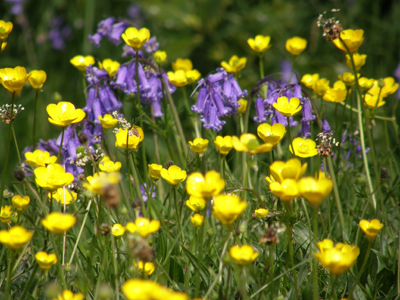If I close my eyes and think back to my childhood, I picture myself with my grandparents walking through the woods near to my house. I can hear the damp rustling of the leaves, and feel the cold caress of the stark spring air. The most vivid memory I possess, that I constantly revisit in times of great stress, is the sights and smells of the abundant wildflowers awakening from a frosty death. They blanket the woodland landscape, or lay clustered in unorganised meadows. Sickly sweet aromas and flashes of colour that fixated my childish imagination with thoughts of the magical creatures that undoubtedly lived amongst them.
I know that I am not alone in having fond memories of our astonishingly beautiful and diverse array of British wildflowers. They are embedded in British culture; a vibrant symbol of life on a rainy, scraggly isle. However, the intensification of agriculture in the last century has led to a disastrous decline in floral populations. The indiscriminate use of herbicides, the depletion of groundwater, and the destruction of natural habitats has led to the disappearance of 97% of this country’s wildflower meadows. Some counties, such as Warwickshire, are losing up to two species of wildflower a year.
The indiscriminate use of herbicides, the depletion of groundwater, and the destruction of natural habitats has led to the disappearance of 97% of this country’s wildflower meadows
This year, the environmental group PlantLife has called for the British government to reclaim 120,000 hectares of land for the conservation of endemic plant species. Activists argue that these meadows, and similar habitats, are keystones of our nation’s ecosystems and that, in turn, the loss of these areas has led to huge declines in pollinator numbers. The potential damage to Britain’s ecology is incalculable. PlantLife’s botanical specialist, Dr Trevor Dines, stated “we know when a woodland disappears because the chainsaws move in; you can see the trees crashing down. But somebody can go into an ancient, wildflower-rich meadow and plough it up within an afternoon, and centuries of carefully managed habitat has disappeared instantly.”
Research by Professor Bill Kunin, Professor of Ecology at the University of Leeds, has shown that although biodiversity loss has slowed since the mid 20th century, the decline is still around 10%. With Brexit on the horizon, the fate of this nation’s wildlife is on shaky ground. The backbone of wildlife protection laws in the UK are provided by the EU (most notably the Wildlife and Countryside Act 1981), and Brexit could provide many dangerous loopholes that permit the exploitation of previously protected lands.
The backbone of wildlife protection laws in the UK are provided by the EU (most notably the Wildlife and Countryside Act 1981), and Brexit could provide many dangerous loopholes that permit the exploitation of previously protected lands.
Alternatively, Brexit could be a huge opportunity to overhaul outdated and overly rigid legislation. In the right hands, Britain could lose the ‘one size fits all’ attitude of EU conservationists, providing practical solutions to specific wildlife problems and rewarding British landowners for conservation successes. Improved flexibility in environmental laws would also allow landowners to self-manage. This would not only reduce the cost of regulation but also foster better relationships between these landowners and environmentalists.
It’s up to us as individuals to remember the cultural, as well as the ecological, significance of our nation’s flora and to remind our government of its inherent value. Especially with Brexit looming ever nearer. Do we want our children to live in a world where a walk in the Yorkshire Moors is missing the eclectic beauty of a Lady’s Mantle or a Melancholy Thistle? Where the only scent in the air is the whiff of cowpats? As Joni Mitchell once said: “They paved paradise, and put up a parking lot.”
Image source: https://www.countrylife.co.uk/gardens/12-top-wildflower-meadows-to-visit-6669

